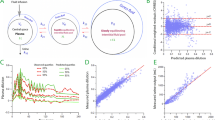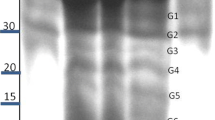Summary
Renal function and distribution of51Cr-EDTA in intra/extravascular space has been studied in rats suffering from the gastro-intestinal syndrome after supralethal doses of X-irradiation. Urine excretion and glomerular filtration were found to decrease until 50 hrp.i. Urine excretion and, in a less degree, glomerular filtration rate increase then to a peak at 67 hrs before falling off to zero values before death. The extravascular space was found to be expanded in several organs from 60 hrs on (kidney, liver, stomach, intestine). Only in kidney where weight follows changes in extravascular space, a return to normal values is seen before death. An expansion in extravascular space due to a reduced re-extraction into intravascular space and diminished excretion constant can also be discerned beginning early after exposure on the basis of compartmental analysis of the blood activity-time curves. It is postulated that the changes observed reflect a state of shock developing slowly after irradiation and entering its irreversible stage 60 to 65 hrs after exposure.
Similar content being viewed by others
References
Appelgren, K. L., Lewis, D. H.: Capillary flow and capillary transport in dog skeletal muscle in hemmorhagic shock. Europ. Surg. Res.4, 29–45 (1972)
Bock. K. D. (Ed.): Shock pathogenesis and therapy. Berlin-Göttingen-Heidelberg: Springer 1962
Bohle, A., Herfarth, C., Krecke, H. J.: Beitrag zur Morphologie der Niere beim akuten Nierenversagen. Klin. Wschr.38, 152 (1960)
Bond, V. P., Fliedner, T. M., Archambeau, J. O.: Mammalian radiation lethality. New York-London: Academic Press 1965
Chien, G.: Role of the sympathetic nervous system in hemmorrhage. Physiol. Rev.47, 214–288 (1967)
Eddy, H. A., Casarett, G. W.: Intestinal vascular changes in the acute radiation intestinal syndrome. In: Gastrointestinal radiation injury, pp. 385–392 (Sullivan, M. F.,Ed.). New York: Excerpta Medica Foundation 1968
Folkow, B., Neil, E.: Circulation. New York: Oxford University Press 1971
Gerber, G. B., Remy-Defraigne, J.: Untersuchungen zum Harnstoff-Stoffwechsel beim gastrointestinalen Syndrom nach Ganzkörperbestrahlung. Z. ges. exp. Med.150, 33–40 (1969)
Gerber, G. B., Altman, K. L: In: Radiation biochemistry, Vol. II (Altman K. I., Gerber, G. B., Okada, S.,Eds.). New York: Academic Press 1970
Gerber, G. B., Gilliavod, N., Deroo, J.: Renin-Angiotensin and aldosterone in the gastrointestinal syndrome after whole body irradiation. Int. J. Radiat. Biol. (in press)
Gerber, G. B., Watters, C.: Untersuchungen zum Mechanismus des gastrointestinalen Syndroms. Berichte der Schutzkommission am Bundesministerium des Innern. Tagung, München, pp. 107–120 (1974)
Gits, J., Gerber, G. B.: Electrolyte loss, the main cause of death from the gastrointestinal syndrome. Radiat. Res.56, 18–28 (1973)
Kabal, J., Baum, S. J., Parkhurst, L. J.: Canine intestinal vasoactivity during the development of the gastrointestinal syndrome. Radiat. Res.50, 528–538 (1972)
Liu Ching-Tong, Overman, R. R.: Effects of whole body irradiation on renal function and renal hemodynamics in the dog. Radiat. Res.25, 552–565 (1965)
Lukin, L., Gregersen, M. L.: Premortal blood volumes in splenectomized dogs after total body X-irradiation. Radiat. Res.7, 161–166 (1957)
Lushbaugh, C. C.: Theoretical and practical aspects of models explaining “gastrointestinal death” and other lethal radiation syndromes. In: Comparative cellular and species radiosensitivity, pp. 288–293 (Bond, V. P., Sugahara, T.,Eds.). Tokyo: Igaku Shoin 1969
Marquardt, D. W.: An algorithm for least squares estimation of non linear parameters. J. SIAM.2, 431–441 (1963)
Mills, L. C., Moyer, J. H. (Eds.): Shock and hypotension. New York: Grune and Stratton 1965
Munck, O., Ladefoged, J., Pedersen, F.: Distribution of blood flow in the kidney in acute renal failure. In: Pathogenese und Klinik des akuten Nierenversagens I (Gessler, U.Ed.) Stuttgart: Thieme 1971
Oken, D. E., Dibona, G. F., McDonald, F. D.: Micropuncture studies of the recovery phase of myohemoglobinuric acute renal failure in the rat. J. clin. Invest.49, 730–737 (1970)
Reubi, F. C., Vorburger, C., Tuckman, J.: Renal distribution volumes of indocyanine green,51Cr EDTA and24Na in man during acute renal failure after shock. J. clin. Invest.52, 223–235 (1973)
Sapirstein, L. A., Sapirstein, E. H., Bredemeyer, A.: Effect of hemorrhage on the cardiac output and its distribution in the rat. Circulat. Res.8, 135–148 (1960)
Vorburger, C., Riedwyl, H., Reubi, F.: Vergleichende Studien zwischen den renalen Clearances von Na-Cr2 51Cr-äthylen-diamintetraacetat, Inulin und Natriumthiosulfat beim Menschen. Klin. Wschr.47, 415 (1969)
Watters. C.. Gerber, G. B.: Regional blood flow in rats exposed to supralethal doses of whole body X-irradiation. Rad. and Environm. Biophysics12, 303–313 (1975)
Weil, M. H., Shubin, H. (Eds.): Diagnosis and treatment of shock. Baltimore: Williams and Wilkins 1967
Welbourne, T. C., Spurr, G. B.: Mechanism of renal acid excretion following X-irradiation of the dog. Radiat. Res.47, 472–479 (1971)
Wykoff, M. H.: The effect of fast neutron irradiation on blood pressure and the response to epinephrine and acetylcholine in the rat. Radiat. Res.49, 624–630 (1972)
Wyler, F., Neutze, J. M., Rudolph, A. M.: Effects of endotoxin on distribution of cardiac output in unanesthetized rabbits. Amer. J. Physiol.219, 246–251 (1970)
Zaruba, K.: Renal functions in acute radiation sickness. Radiat. Res.25, 1–8 (1965)
Zweifach, B. W., Kivy-Rosenberg. E.: Microcirculatory effects of wholebody X-irradiation and radiomimetic procedures. Amer. J. Physiol.208, 492–498 (1965)
Author information
Authors and Affiliations
Additional information
Supported by the “Schutzkommission am deutschen Innenministerium” Publication No. 1051 of the Euratom Biology Division.
Rights and permissions
About this article
Cite this article
Watters, C., Gerber, G.B. Renal function and intra/extravascular distribution spaces in the rat after supralethal whole-body X-irradiation. Radiat Environ Biophys 12, 291–302 (1975). https://doi.org/10.1007/BF01323417
Received:
Issue Date:
DOI: https://doi.org/10.1007/BF01323417




